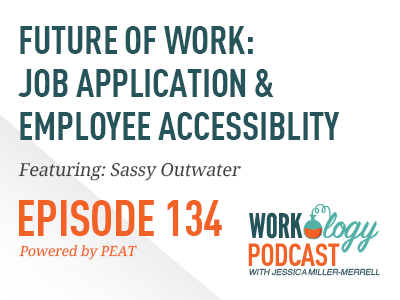It’s important to walk a mile in another person’s shoes. I encourage this often when it comes to understanding the job seeker journey and certainly when talking with employees whether it’s through focus groups, surveys or applying for jobs at your company to understand first hand what the process is like. That’s certainly true when we talk about employees with disabilities whether it’s the job search or the work environment, it’s important to talk to adults to understand how we can make the workplace more accessible.
As part of our Future of Work series in partnership with PEAT, we wanted to explore more about technology specifically machine learning and how it is providing work opportunities for adults with disabilities.
Episode 134: Future of Work: Job Search and Employee Accessibility with Sassy Outwater (@sassyoutwater)
Sassy Outwater is the Director of the Massachusetts Association for the Blind and Visually Impaired or MABVI. MABVI provides vision rehabilitation services and community partnerships to eliminate barriers and create opportunities for people who are blind or have low vision in both work and life. My interview with Sassy is truly a remarkable one.
In this interview on the Workology Podcast, Sassy talks through the application, interview, and hiring process that job candidates experience when they have a disability. This conversation and feedback is an important one for employers to hear. Candidates with disabilities more often than not are not able to navigate a company’s career site let alone complete an application. Whether it’s an assessment timing out or buttons on your career site that aren’t labeled, candidates who have disabilities whether it’s a vision impairment like Sassy or deaf, a cognitive disability or other, the hiring process is difficult if not impossible for people with disabilities.
Disability As an Employee Advantage
One of the more striking moments from my interview with Sassy is that her disability provides her a unique experience and perspective allowing her to view the world differently. She says her experiences as someone who is sight impaired make her approach situations and offer solutions that are different from her peers. These are the types of skills, abilities, and problem-solving we need in our workforce. Sassy views her disability as an advantage for herself as a contributor and employee at her organization, and I have to agree. It’s our differences that make us special and Sassy shares candidly.
Accessible HR Technology
When it comes to technology for the workplace especially in HR and recruiting technology, Sassy believes we have a long way to go. HR technology in her experience often tells HR and workplace leaders it is accessible, however, once you sign the contract and begin to implement the software, she finds that it isn’t accessible. It was something that Sassy learned the hard way while being charged with processing payroll for an employer. The HR technology wasn’t compatible with the screenreader she uses every day.
Sassy says that the best way to ensure that the HR technology you implement or adopt is accessible is by talking with your staff and have them demo the technology. She suggests leveraging their expertise and experiences to ensure that the products and services you provide for everyone employees, as well as candidates, are a great one. Personally, I think this is something we are really missing when it comes to the “inclusive” candidate and employee experience.
Making the Workplace More Accessible with Tech
There are a growing number of technologies that exist making the workplace more accessible for all. One of them is a pair of wearable glasses called Aira. Aira connects the wearer to a real-time person who can help the user navigate the world whether it’s helping to view or update a Powerpoint presentation or ensure that a ensure that the paper from the printer is the right one. Aira is available at her workplace for everyone including guests. Those with a pair of glasses or a smartphone can connect with Aira over the phone.
Sassy says, “All technology is assistive technology,” and that is certainly true. It’s important to talk to employees who have a disability at your office, a friend or a trusted expert like Sassy to understand how you can make your workplace more accessible. I think that sometimes it might seem overwhelming, but the best place to start is right now whatever focus, direction or accessible tool or program you choose to implement. The important thing is to start today.
Connect with Sassy Outwater on Facebook.
RECOMMENDED RESOURCES
How to Subscribe to the Workology Podcast
You can also click here to find out how to be a guest on the Workology Podcast.









